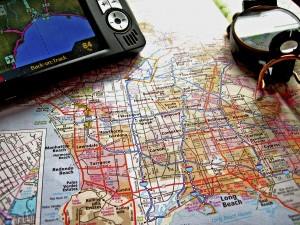Over the past ten years or so there has been a massive increase in the amount of technology that we can use when driving. While this technology can either entertain us or aid our driving, it can also distract us. In fact, some research has suggested that distractions may account for up to 78% of crashes[1]. Much of the research and media attention has been focused on the use of mobile phones when driving; however the use of satellite navigation systems has become commonplace, with over 14 million in use in 2008. Relatively little is known about the advantages and disadvantages of using these systems.
 The main problem with using mobile phones when driving is that your attention is divided between two tasks: talking and driving. You cannot give either your full attention, therefore your driving skills decrease. There seems to be a similar effect when using sat navs. Cases of drivers ending up on the edge of a cliff, on railway lines or on roads too narrow for a car to pass through have been well publicised in the media. If they were paying attention how could this have happened? What has research shown us about how we use satellite navigation systems?
The main problem with using mobile phones when driving is that your attention is divided between two tasks: talking and driving. You cannot give either your full attention, therefore your driving skills decrease. There seems to be a similar effect when using sat navs. Cases of drivers ending up on the edge of a cliff, on railway lines or on roads too narrow for a car to pass through have been well publicised in the media. If they were paying attention how could this have happened? What has research shown us about how we use satellite navigation systems?
Intuitively, it might seem that the use of a navigation system would be less distracting than using a mobile phone. However, research has shown that drivers are more likely to be distracted by a task that is relevant to their driving, such as map reading, than to something that is irrelevant[2]. It’s therefore possible that the use of sat navs might distract a driver or interfere with their ability to drive safely.
While there may be some negative effects from using sat navs, they are used for a good reason – to navigate our way to a destination. Drivers have needed to achieve this since long before sat navs came into use! Maybe a more relevant question is whether sat navs are safer, or less distracting, than the traditional paper map?
One study compared driving performance when using either a sat nav system or a paper map[3]. They found that drivers using a sat nav system reached their destination faster and took a shorter route to their destination. However, the sat nav users also drove significantly faster and drove more aggressively around corners. So it seems that the use of sat navs in fleet cars would bring some advantages in terms of efficiency, but may bring some increased risks at the same time.
It’s unlikely that the use of sat navs will decrease and they have many obvious benefits for drivers, so how can we minimise the negative effects of using sat navs? There seems to be two approaches to this issue.
First, much research is being conducted to improve the sat nav systems in order to reduce the cognitive load that is placed on the driver, so that they can focus their attention more on driving. One line of research is comparing the usual head down display with a head up display for the use of sat nav systems when driving. One study asked commercial lorry drivers to drive in a simulator using either a head down or head up display[4]. They found that drivers using a head up display responded faster to emergency situations and maintained more consistent driving speeds.
Current sat nav systems provide the driver with information about when to complete a manoeuvre on the basis of distance. One research group[5] is examining how verbally identified landmarks, for example “turn right after the pedestrian crossing”, might be used to improve the information that drivers are given by navigation systems. Half of the participants received direction on the basis of distance and half on the basis of landmarks. They found that the participants being given landmark instructions were more confident in their driving, spent less time looking at the sat nav display and made fewer driving and navigation errors.
The second approach is to help drivers to better understand the risks involved when using a sat nav and to develop driving techniques to avoid the possible dangers that are encountered. For example, being more selective about when to look at the device, not making sudden changes of direction and trusting your own common sense, can help you to drive safely whilst still having the advantages of a navigation system.
[1] Neale et al. (2005)
[2] Cnossen et al. (2004)
[3] Lee and Cheng (2008)
[4] Liu and Wen (2004)
[5] May et al. (2005)
Dr Victoria Bourne (BA Hons, DPhil)
Consultant to Driving Risk Management Limited

